|

|

INJURY:
There are many types of ants that may be found in houses. Some
are actual household pests, while others occasionally wander in to
look for food or water.
Ants are often nuisance pests and just their presence can be upsetting. They often get into foods and feed on them. Some species crawl over refuse, carrion or sewage which may afford them an opportunity to carry the causal organisms of some diseases. Food contamination can also occur and may result in allergic reactions by certain sensitive people. Some ants damage wooden structures, and others undermine slabs or patio stones. But, we should not forget that ants are beneficial in their natural habitat because they help clean up the environment.
DESCRIPTION:
Ants have three body regions (head, trunk and gaster)
distinctly defined by narrow constrictions. They have elbowed
antennae, and the gaster is attached to the thorax by a waist that
consists of one or two small separated segments.
There are three distinct castes of ants - queen, male and worker. There may also be different forms of each casts. Ants always live in societies known as colonies. Workers are wingless, but at mating time swarms of males and females are produced, usually winged.
LIFE HISTORY:
Adult winged males and females emerge from their cocoons and
eventually leave the nests. Emergence of large numbers of ants
(swarming) usually occurs at certain times, and often this is the
only time we notice the ants at all. Males seek out females in the
swarm; mating usually occurs in the air. Males die soon after the
mating flight, while female (queen) starts a new nest. She removes
her wings, forms a small cell and starts a new colony by laying
several eggs. The young queen tends the eggs and the larvae that
hatch from them feeding them by trophallaxis. Some of the food comes
from the breakdown of the wing muscles, but if there is a shortage of
food, a few of the larvae may be eaten also. The queen does not leave
the cell to forage for food, except in some primitive hunting ants.
The surviving larvae mature, from pupae with or without spun cocoons, and finally emerge as adult ants. The workers are sterile, wingless females. The first workers are dwarfs, called nanites. When the workers emerge, the queen retires as nursemaid and concentrates on her job of egg production. The nanites take over as nursemaids for the next batch of eggs -- they hunt for food outside the nest and do a better job of rearing larvae. Under their care, the larvae produce normal-sized workers. Adult workers may live for weeks, or up to two years or more. Queens have been known to live for as long as 20 years.
After a colony is well established, some of the larvae will now
develop into males and females which will take off in the mating
flight.
Back to Pest Information
|
|
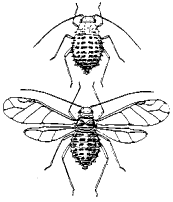 Winged andwingless forms |
DESCRIPTION: INJURY: |
In addition to the direct damage caused to the plant by the aphids feeding a black fungus, known as sooty mold, grows on the honeydew secreted by the aphids. Sooty mold is unsightly and in association with honeydew it is objectionable to the buyer of affected plant material, fruits or vegetables.
LIFE HISTORY:
Most species of aphids overwinter in the egg stage. The eggs
hatch in the spring to produce a generation of females. These female
aphids give birth to living young. Generally the first young aphids
are wingless, however, when a colony becomes too crowded, winged
forms may be produced. The winged forms migrate to new host plants
and begin new colonies. Enormous populations are built up from these
overlapping generations all summer long.
Late in the season the aphids migrate back to the original host plant, and a generation consisting of both males and females is produced. These individuals mate and the females lay eggs which will overwinter.
MONITORING:
Carefully inspect plants for the beginning of an aphid
population buildup. Check for natural enemies such as mummies
(gray-brown bloated parasitized aphids indicating wasp parasites at
work), and the alligatorlike larvae of lady beetles and lacewings.
Yellow sticky boards are also used as a monitoring toll for aphid
populations. Aphids are attracted to the yellow color and often are
visible on the cards before they are detected on the plant.
Back to Pest Information
|
Rhagoletis pomonella |
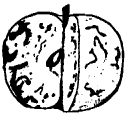 Apple Injured by Apple Maggot |
INJURY: Signs of the infestation on the fruit are minute egg punctures in the skin and pitted areas on the surface. In late season varieties the injury usually appears as corky spots or streaks in the flesh. In the varieties ripening during July, August and September open tunnels may occur. Rot producing organisms follow the maggots causing rapid decay of infested fruit. |
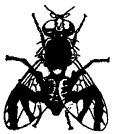 Apple Maggot Fly |
LIFE HISTORY: The flies require approximately 10 days after emergence to feed, mate and lay eggs. During this time they may be seen resting on the leaves or fruit of apples and other host plants lapping up drops of honeydew or moisture with their fleshy mouth parts. |
The female has a sharp ovipositor with which she punctures the skin of the apple and inserts her minute whitish egg into the pulp of the fruit. A large number of eggs may be deposited in a single fruit, and fruits of late varieties become much dimpled and pitted as a result.
The eggs hatch in 4 to 6 days, young maggots beginning at once to tunnel through the fruit causing brown trails. Severely infested fruits often fall to the ground early. The numerous trails in the fruit reduce the inside of the apple to a brownish pulpy mass and render it unfit for consumption.
The full grown maggot (about 3/8 inch long) leaves the fallen fruit and burrows into the soil to a depth of 1 to 2 inches. Here it changes to a puparium in which stage it overwinters. The following year the cycle starts again.
MONITORING:
Monitoring for these insects will help you determine when AM
is active in your area and this information will help you with
management decisions. Home gardeners may use visual traps to
effectively monitor apple maggot populations. Red sphere traps and
yellow sticky boards are two types which are currently available, but
red spheres are better and more accurate. Synthetic volatile lures
are now available, which greatly increase the efficiency of traps.
Traps should be place in mid (Southeastern NY) to late June (Upstate
NY) at head height, clearly visible on the outside edge of the
canopy. Traps should be checked 1-2 times per week for AM flies. If a
cumulative average of 5 AM flies/baited trap is caught a spray of a
suitable pesticide is recommended, and the traps can then be ignored
for 10-14 days (the period of time the spray residue will protect the
fruit). Begin checking traps again after the protection period.
Trapping can be stopped by August 30. Traps should be cleaned of
insects periodically and recoated with stickum if necessary. No
treatment is recommended until a cumulative total of 5 AM flies per
trap are caught.
Back to Pest Information
|
|
At certain times of the year, you may notice an odd creature attracted to the outside light or on the porch. The following are four of the more common insects that attract attention because of their size, shape, or numbers. These insects are not harmful. Occasionally insects such as these are considered an annoyance, but usually the problem does not last long. The immature stages of these insects are aquatic, living in water.
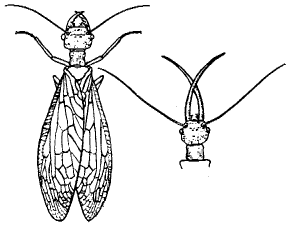 Female Dobsonfly (left) Head of Male Dobsonfly (note large mandibles) (right) |
DOBSONFLIES: The larvae, often called hellgrammites, are found under stones in swift moving streams and are used by fishermen for bait. Before you try them for bait -- remember these insects have strong jaws and can inflict a painful bite. The larvae may live for three years before transforming to adults and may be as long as 2 or 3 inches when full grown. Hellgrammites are predaceous insects feeding on small aquatic life. |
 Adult Mayfly |
MAYFLIES: The nymphs live in clear fresh waters and feed on vegetable matter including diatoms and desmids (which make the gold-green color upon stones of the brook bottom). They will also feed on soft tissues of larger plants, either alive or dead. |
 Midges |
MIDGES: |
 Stonefly Nymph |
STONEFLIES: The nymphs are found under stones, around branches, or in debris in the stream bed. Most are vegetarians, feeding on dead organic matter, but a few are predaceous. When the nymph completes development, it crawls out of the water and takes firm hold on a rock, stick or other nearby object. Very soon it goes through the final molt, the nymphal skin splits right down the center of the back and the adult stonefly emerges. Within a few minutes, the wings are hardened and the insect is ready for flight. The adults live only a few weeks. Both stoneflies and mayflies may occur by the millions at bright lights near bodies of water. In such instances they are an extreme annoyance. There is however, no way to control them without seriously altering their larval habitat. They do not last long. |

CADDISFLIES:
The caddisflies are small to medium-sized insects that look
somewhat like moths in overall appearance. The wings are usually held
roof-like over the abdomen when the adult insect is at rest. Unlike
moths, the wings and body are covered with hairs, not scales.
The larvae are aquatic living in lakes and streams. Most of the
larvae construct "portable homes" or cases. Many types of materials
are used in the case construction including small stones, sand
grains, leaves, sticks, conifer needles and even small snail shells
held together by silken threads. The cases are often found attached
to vegetation near the aquatic site. The larvae feed on aquatic
animals with a few species predaceous on insects. After the larval
stage is completed, the insect pupates inside the case and seals the
entrance with silk.
Back to Pest Information
|
Argyresthia sp. |
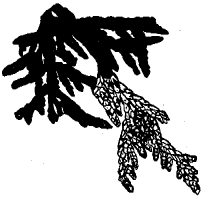 Arborvitae leafminer damage |
DESCRIPTION: INJURY: |
LIFE HISTORY:
The adults are active from late May to early June. Many tiny
glittering moths may call attention to an infestation. After mating,
the females deposit eggs on the inner edges of the arborvitae leaves.
The young larvae enter the leaves and mine or excavate between the
leaf surfaces. The larvae overwinter in the mines and resume feeding
for a short while the following spring. Pupation occurs in late May
and the adults emerge soon after.
Back to Pest Information
|
|
There are two species of beetles that attack and cause economic damage to asparagus in New York. They are the common asparagus beetle, Crioceris asparagi (Linnaeus), and the spotted asparagus beetle, Crioceris duodecimpunctata (Linnaeus). The common asparagus beetle is in the more widespread of the two species.
 Common Asparagus Beetle (x5) |
DESCRIPTION: The larva or grub of this beetle is dark gray to olive green with black legs and head. INJURY: |
LIFE HISTORY:
Adult beetles overwinter in sheltered places such as piles of rubbish
and heaps of old asparagus tops. They emerge from their shelter when
the new shoots come up and begin feeding on the tender tips. They
soon lay eggs on the young shoots. The eggs are elongate, oval and
deposited either singly or in rows of two to eight. Later in the
season the eggs are laid on leaves and flower stems.
The eggs hatch in 3 to 8 days and the grubs begin feeding on the tender tips. When the grubs mature, they drop to the ground and construct a small earthen cell where they transform into pale yellowish pupae. The adult beetles emerge from the pupae. There may be two or more generations a year depending on the climate.
 |
DESCRIPTION: INJURY: |
LIFE HISTORY:
The adult beetles overwinter in piles of debris. They leave
their winter quarters about one week later than the common asparagus
beetles and begin to feed on the tender young shoots. They do not
deposit eggs until the plant begins to blossom, about three weeks
after they've emerged. The egg is deposited singly on plants, usually
those bearing fruit. The egg is 1/25 inch in length, olive brown and
attached to the leaf by one side.
The grubs hatch in 7 to 12 days and are yellowish-orange in color with a black head and legs. The larva finds a berry and enters it at the blossom end. Inside the berry, it feeds on the seeds and it may attack 3 or 4 berries before it is mature. When fully grown, it drops to the ground by a silken thread and spins a cocoon just under the soil surface. In New York State a second brood usually occurs in July.
a

|
This site is developed and administered by Lake Technology Solutions, Inc. | www.LakeTS.com | (888) 332-8082 |